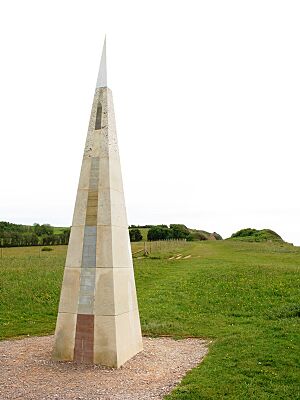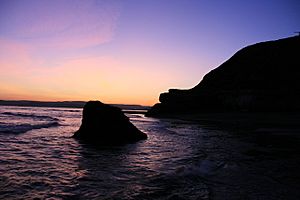Orcombe Point facts for kids

Orcombe Point is a beautiful spot on the coast near Exmouth, in Devon, England. It's located on the south coast, about 10 miles (16 km) south of the city of Exeter. It's also about 2 miles (3.2 km) southeast of Exmouth town centre.
To the west of Orcombe Point is Exmouth Beach. To the east, you'll find Sandy Bay, which is a popular holiday beach. You can reach Sandy Bay by walking along the coastal path or through a large caravan park. At low tide, these two beaches connect below Orcombe Point, forming one long stretch of sand.
Contents
The Geoneedle: A Special Landmark
High up on the hill at Orcombe Point, you'll see a unique sculpture called the "Geoneedle". This special landmark was officially revealed in 2002 by Prince Charles (who is now King Charles III).
The artist who created the Geoneedle was Michael Fairfax. He also designed another famous sculpture called the "Exeter Riddle" in Exeter. The Geoneedle is built using many different types of stone. These stones represent the main rocks found along the Jurassic Coast. They also show the order of the rock layers that make up this part of the coastline. It's like a stone timeline!
Discovering Orcombe Point's Geology
Orcombe Point is super important because it marks the very start of the Jurassic Coast. This famous coastline is a UNESCO World Heritage Site. It stretches for 95 miles (153 km) along the coast of Devon and Dorset. The South West Coast Path, a long walking trail, follows the entire length of the Jurassic Coast.
How Rocks Formed Here
The rocks at Orcombe Point gently slope towards the east. Because of this slope and millions of years of erosion, the oldest rocks are found here in the west. As you move further east along the cliffs, you'll find progressively younger rocks.
The cliffs along the Jurassic Coast show a continuous sequence of rock layers. These layers formed over about 185 million years! They include rocks from three major time periods:
- The Triassic period
- The Jurassic period
- The Cretaceous period
Many places along the Jurassic Coast are famous for their amazing fossil discoveries.
Layers of Ancient Earth
As you walk up to Orcombe Point, you can see different layers of sedimentary rock. These rocks were laid down under various geological conditions a very long time ago.
At the bottom of the cliffs, you'll find sandstones with special patterns called cross-bedding. This means they were formed by moving water or wind. Higher up, the rocks change to siltstones and mudstones. These types of rocks form in calmer, slower-moving water.
The rocks here are very red. This red color tells us something amazing: they were formed in a hot, dry desert environment! These ancient rock formations belong to the Aylesbeare Mudstone Group. They date back to the Triassic period, which was about 250 million years ago.


